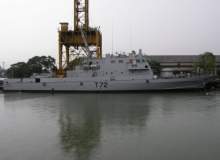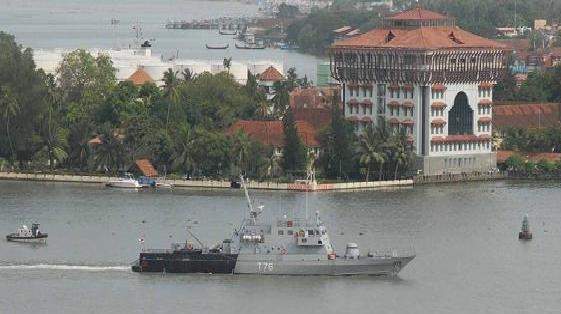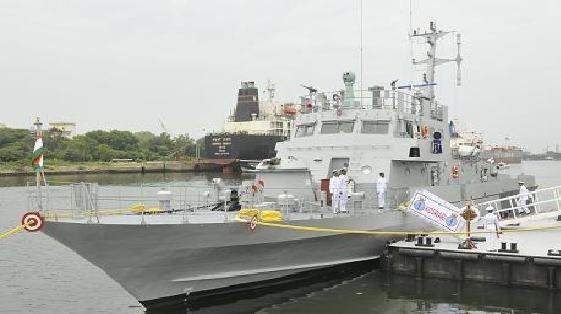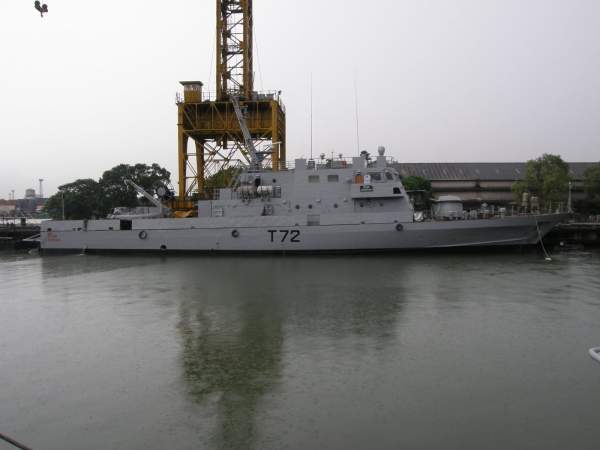Car Nicobar Class fast attack craft (FAC) of the Indian Navy were built by Garden Reach Shipbuilders and Engineers (GRSE) in Kolkata, India, between 2007 and 2011. The class is preceded by the Bangaram Class patrol vessels. Named after Indian islands, the Car Nicobar Class FAC are the first water jet-propelled ships of the Indian Navy.
In March 2006, the Indian Navy placed an order with GRSE for the delivery of ten water jet-propelled FAC. The keel for the first two ships in the class, INS Car Nicobar (T69) and INS Chetlat (T70), were laid down in January 2007.
The ships were launched in November 2009 and commissioned in February 2009. INS Kora Divh (T71) and INS Cheriyam (T72) were laid in August 2007, launched in July 2008 and commissioned in September 2009. INS Cankarso (T73) and INS Kondul (T74) were laid in July 2008, launched in March 2009 and commissioned in June 2010.
INS Kalpeni (T75) was laid in July 2008, launched in March 2009 and commissioned in October 2010. INS Kabra (T76) was laid in March 2009, launched in March 2010 and commissioned in June 2011. INS Koswari (T77) was laid in March 2009, launched in March 2010 and commissioned in July 2011. The last ship in the class, INS Karuva (T78), was laid in March 2009, launched in March 2010 and commissioned into the Indian Navy in August 2011.
The Indian Navy also ordered a follow-on series of four improved Car Nicobar Class variants known as the follow-on Water Jet Fast Attack Craft (WJFAC).
The first and second vessels in series, INS Tarmugli and INS Tihayu, were respectively commissioned to the Indian Navy in May and October 2016. The third WJFAC, INS Tillanchang, was delivered to the Indian Navy in December 2016. The Car Nicobar Class fast attack craft are designed to conduct patrol, anti-piracy and search and rescue missions in the Exclusive Economic Zone (EEZ) of India. The vessels can also be used for the interception of fast-moving surface craft, anti-smuggling and fisheries protection.
In January 2011, INS Cankarso and INS Kalpeni were deployed on an anti-piracy mission as a part of Operation Island Watch.
Car Nicobar Class vessel design and features
The Car Nicobar Class features a more efficient hull-form design than the earlier FAC version of the GRSE. The original design was modified based on the inputs from the navy. The modified aluminium superstructure significantly reduces the radar cross-section. The low draft of the vessel allows for operations in shallow waters close to the coastline.
The vessels are equipped with Furuno navigation radar, surface search radars and a sonar system. The class has a sewage treatment plant and a reverse osmosis plant for desalination.
The ships offer improved habitability with fully air-conditioned standard accommodation. The boats comply with the International Maritime Organisation (IMO) regulations on sea pollution control.
The fast attack craft has an overall length of 52m and moulded depth of 4m. The full load displacement of the vessel is 325t. The ship can complement a crew of 39, including four officers and 35 sailors.
Weapon systems and propulsion of the Indian fast attack craft (FAC)
The main gun fitted on the bow deck is a CRN-91 30mm auto-cannon. It is the naval version of the 2A42 30mm Medak gun. The gun can fire 550 rounds a minute for a maximum range of 4,000m. The firing is controlled by an electro-optic fire control system jointly supplied by the Ordnance Factory Board and Bharat Electronics.
The Car Nicobar Class is also armed with two 12.7mm heavy machine guns, multiple medium machine guns and an Igla Man-Portable Air-Defence System (MANPADS) to combat aerial threats. The ships have anti-submarine warfare (ASW) capability.
The Car Nicobar Class is powered by three MTU 16V 4000 M90 engines driving Hamilton HM811 waterjet units. The engines deliver a power output of 8,160kW. The propulsion system provides a maximum speed of more than 35k.
The maximum speed of the first two vessels was initially restricted to 27k due to flaws in the gearboxes. The problems were later rectified by the supplier Kirloskar. The last three vessels were equipped with ZF gearboxes in place of Kirloskar units.







